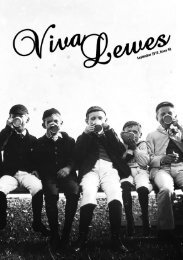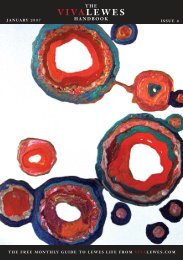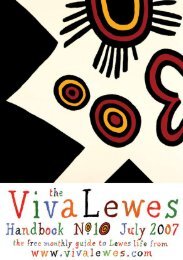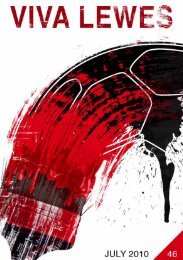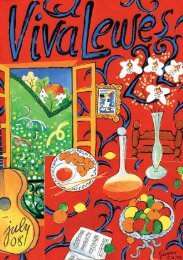You also want an ePaper? Increase the reach of your titles
YUMPU automatically turns print PDFs into web optimized ePapers that Google loves.
Photographs: Alex Leith<br />
Southease<br />
Alex Leith visits a well-connected hamlet<br />
The first time I went to Southease, a few years ago, I<br />
asked a villager if he could point out where the village<br />
pub was. “The Black Lamb?” he replied, pointing to a<br />
sloping grey roof the other side of the church. “It’s over<br />
there.” I headed thirstily towards it, only to realise he<br />
hadn’t finished. “But you won’t get a drink there,” he<br />
shouted behind me. “It’s been closed for 400 years.”<br />
“It would be nice to have a pub,” says Adrian Orchard,<br />
a nurseryman who has been living and working in the<br />
village since 1991, when I tell him this story. “But the<br />
central focus of the village’s social life is actually the<br />
church.” Adrian is giving me a tour of Southease, and<br />
we are standing in front of the aforementioned building,<br />
which dates back at least to 966, and is one of three<br />
churches in East Sussex to boast a round tower, its spire<br />
quaintly shingled with oak tiles. It is surrounded by lichen-covered<br />
gravestones, and rises splendidly into the<br />
freezing sky, set off by the moody leafless trees that<br />
shiver behind it. One of the gravestones, I’m told, is<br />
the subject of quite a mystery.<br />
Adrian has been serving me cups of coffee in the beautiful<br />
cottage round the corner he shares with his wife<br />
Jane, and telling me about life in Southease, and the<br />
history of the village. I learn a lot. The name means<br />
‘south thicket’, apparently, and the Domesday Book<br />
reveals that in 1086 ‘Sueise’ hosted quite a thriving<br />
community, making its living from farming and fishing.<br />
The villagers were annually assessed for 38,500 herrings<br />
and £4-worth of porpoises. “The river used to be<br />
a lot wider, and it is thought that there was quite a sizeable<br />
harbour here,” says Adrian, who admits he doesn’t<br />
know how many porpoises £4 would buy you in Norman<br />
times. In the same period Brighton was assessed<br />
for only 4,000 herrings, which is quite an indicator of<br />
how important Southease once was. It now has only<br />
30 or so full-time residents, living in 15 houses, spread<br />
around the church and the bumpy, shapeless village<br />
green in front. One of them is splendidly thatched.<br />
We walk into the church, which I have been warned by<br />
Jane ‘is as cold as an arctic tomb.’ On the wall you can<br />
make out the remains of some 13th century wall paintings,<br />
sadly almost faded out of existence, but immortalised<br />
by a 1930s framed depiction hung below. I learn,<br />
from a textbook handily left open at the right page, that<br />
the church used to be much bigger in its heyday. ‘The<br />
Norman church has mislaid its chancel and aisles,’ it<br />
informs me. Adrian humours me through my lame<br />
‘how careless’ joke and talks of the importance of the<br />
building to the community. The several popular events<br />
the villagers organise through the year – the plant fair<br />
in May, the open gardens in June, and the chilli day<br />
in August – all give a cut of their profits towards the<br />
£60,000 that needs to be raised to mend the roof and<br />
return to its spire its gale-damaged weathervane, as<br />
well as for new lighting and heating.<br />
It certainly needs the heating – it’s significantly<br />
warmer outside as we wander into the graveyard<br />
to check out the mystery grave. It belongs to ‘Sergeant<br />
AJ Vaughan’, a WW2 fighter pilot who was<br />
shot down in Kent in 1941, and buried in Southease<br />
despite having no known connection with the village.<br />
We are joined by Ian, something of an expert<br />
on Southease’s most curious resident, who has discovered<br />
that the more research he does on Sergeant<br />
Vaughan, the more mysterious the Sergeant becomes.<br />
Adrian gives me a lift over Southease Bridge to the<br />
railway station, and tells me of some of the other<br />
activities in the village. The Southeasites annually<br />
collect together all the apples from their gardens,<br />
it seems, and the men of the village show off their<br />
strength of arm on a large apple press. On Saturday<br />
nights the ‘Southease Church Cleaners Union’ meet<br />
up together in the church to tidy the place up, sink<br />
a few glasses of red wine, and discuss village affairs.<br />
Simple stuff for simple folk, stranded in time in a picturesque<br />
but nearly forgotten loop, just off the C7?<br />
Not a bit of it. The station platform I’m left on serves<br />
the villagers with direct trains to <strong>Lewes</strong>, Brighton and,<br />
in the mornings, to London. This makes it one of the<br />
most desirable commuter-belt dwelling-places around;<br />
the best connected hamlet in the South. Not that anywhere<br />
ever comes up on the market more than once in<br />
a blue moon. “Once people get a property here, they<br />
hold onto it for dear life,” says Adrian, and I can understand<br />
why. It’s just a damn pity the Black Lamb had<br />
to close down. V<br />
5 1<br />
W W W. V I V A L E W E S . C O M<br />
V I V A V I L L A g E S






